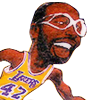- toggle
- Nov 7, 2005
-

|
Was wondering if all the night shots were shot with natural light, the stars looked real in most of those scenes. Is there any where I can read more about the cinematography?
Really great stuff if its all done in camera.
|
 #
¿
Dec 1, 2022 11:44
#
¿
Dec 1, 2022 11:44
|
|
- Adbot
-
ADBOT LOVES YOU
|

|
|
#
¿
May 17, 2024 20:33
|
|
- toggle
- Nov 7, 2005
-

|
There's an extensive technical writeup here:
https://ascmag.com/articles/the-northman
It's a bit of a difficult process to summarize, but the TL;DR is that most of the look was done via photochemical processes. For sequences that were entirely moonlit, they shot day-for-night using a filter that cuts out any color not on the green-cyan spectrum and then desaturated that to a near monochrome. It caused warm colors to become darker, as they appear to human eyes that are using only their rods, as at nighttime.
Sequences with firelight were more complicated. For those, they used HMIs with extremely low pass cyan filters for moonlight and also put a mid cyan filter on the camera lens. The result was that the cyan HMI light would pass through unaffected, but the firelight would be made more neutral. Then they printed everything on a pure red negative. So, the firelight would be warm but the rest of the set would be monochrome as the cyan light and red negative canceled each other out. Again, this is to emulate the way firelight appears to human eyes at night, because anything past a certain luminance threshold will register on your eye's cones which see color, but the rest will only be seen with your rods which only read in monochrome.
The last stage was a digital sky replacement. No way around that with cameras as they work today.
Wow, thatís awesome, thanks for the explanation. Here I was thinking they shot it all with natural light 
Has this technique been used before?
|
 #
¿
Dec 5, 2022 08:29
#
¿
Dec 5, 2022 08:29
|
|





